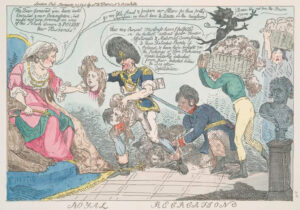 “The Russian soldiers were so bloodthirsty that they even killed animals: horses, dogs, cats… Some devilish lust for the destruction of all life but their own took possession of these savage hordes. Thousands of unfortunate Praga district citizens, trying to make their way to Warsaw, ended up dying in the torrents of the Vistula. As they crowded in terror across the bridge, the piles of the bridge were destroyed, and the Russians fired canister shot from their cannons at those who fled in boats.”
“The Russian soldiers were so bloodthirsty that they even killed animals: horses, dogs, cats… Some devilish lust for the destruction of all life but their own took possession of these savage hordes. Thousands of unfortunate Praga district citizens, trying to make their way to Warsaw, ended up dying in the torrents of the Vistula. As they crowded in terror across the bridge, the piles of the bridge were destroyed, and the Russians fired canister shot from their cannons at those who fled in boats.”
This is what journalist Bruno Korotyński wrote in 1924 about the slaughter in Warsaw’s Praga district. It was one of the last and also most tragic episodes of the Kościuszko Uprising. On 4 November 1794, after the Polish army had been defeated, Cossacks slaughtered about 20,000 civilian inhabitants of the right bank of the capital.
Korotyński went on to write: “there is no exaggeration in the above description of the Praga massacre, no desire to present the enemies in a worse light than they deserve. The best proof of these terrible crimes is the fact that they are described not only by Poles of the time but also by Russians, namely by Russian officers from Suvorov’s army. These, after all, would not have slandered themselves and their compatriots. One of these Russians, Lew Engelhardt, an eyewitness to the massacre, when describing the crimes committed by the army in Praga, said: “at the sight of all this, the heart froze in a man, and the abomination of the image outraged his soul. During a battle man not only feels no pity in himself but bestialises even more; murders, however, after the battle is over, are a great disgrace!”
The Kościuszko Uprising soon collapsed and several thousand soldiers taken into Russian captivity were sent to Sybir.
Empress Catherine II awarded Suvorov, the principal of this murder of innocent people, with a military promotion to the rank of Field Marshal.
Satirical illustration: Massacre of Warsaw’s Praga district in 1794 by Isaac Cruikshank, source: Wikimedia Commons



